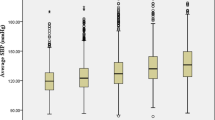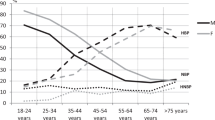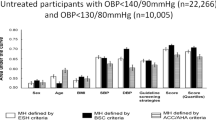Abstract
Surveying the evolution of blood pressure (BP) levels and hypertension (HTN) prevalence is important. A stringent strategy was utilized in a population cohort study. The BP was measured at two visits at least 3 months apart, and the results were analyzed using the following two methods: the Surveillance method (three BP measurements were performed in one visit, and the results were compared with those published previously for the identical method) and the Clinical method (three measurements per visit for two visits, and the concordant results in both visits were used to determine the BP classification). A total of 2542 subjects completed the evaluation. Using the Clinical method, an average systolic/diastolic BP value of 129.8/76.8 mm Hg was obtained, and the prevalence of HTN was 31.6%. Of the hypertensive patients, 74.3% were aware of his/her condition; 69.1% were treated and 40.8% of those treated had adequate BP control. A total of 24.7% of subjects changed his/her BP classification between visits, and 13.7% misreported HTN. Using the Surveillance method, we determined that the average global SBP has been maintained, with HTN prevalence increasing in this region, drifting from reported trends nationally and worldwide. There has been improvement in the proportion of treated and controlled subjects; however, the Surveillance method overestimated the HTN prevalence and underestimated the proportion of treated and controlled subjects. The BP levels were higher than observed worldwide in high-cardiovascular (CV) risk countries as well as higher than the minimum risk exposure level for developing CV disease.
This is a preview of subscription content, access via your institution
Access options
Subscribe to this journal
Receive 12 digital issues and online access to articles
$119.00 per year
only $9.92 per issue
Buy this article
- Purchase on Springer Link
- Instant access to full article PDF
Prices may be subject to local taxes which are calculated during checkout


Similar content being viewed by others
References
Crim MT, Yoon SS, Ortiz E, Wall HK, Schober S, Gillespie C et al. National surveillance definitions for hypertension prevalence and control among adults. Circ Cardiovasc Qual Outcomes 2012; 5 (3): 343–351.
Ikeda N, Sapienza D, Guerrero R, Aekplakorn W, Naghavi M, Mokdad AH et al. Control of hypertension with medication: a comparative analysis of national surveys in 20 countries. Bull World Health Organ. 2014; 92 (1): 10–9C.
Bovet P, Gervasoni JP, Ross AG, Mkamba M, Mtasiwa DM, Lengeler C et al. Assessing the prevalence of hypertension in populations: are we doing it right? J Hypertens 2003; 21 (3): 509–517.
Modesti PA, Rapi S, Bamoshmoosh M, Baldereschi M, Massetti L, Padeletti L et al. Impact of one or two visits strategy on hypertension burden estimation in HYDY, a population-based cross-sectional study: implications for healthcare resource allocation decision making. BMJ Open 2012; 2 (4): e001062.
Kearney PM, Whelton M, Reynolds K, Whelton PK, He J . Worldwide prevalence of hypertension: a systematic review. J Hypertens 2004; 22 (1): 11–19.
Figueiredo D, Azevedo A, Pereira M, de Barros H . Definition of hypertension: the impact of number of visits for blood pressure measurement. Rev Port Cardiol 2009; 28 (7-8): 775–783.
Pereira M, Lunet N, Azevedo A, Barros H . Differences in prevalence, awareness, treatment and control of hypertension between developing and developed countries. J Hypertens 2009; 27 (5): 963–975.
Rothwell PM, Howard SC, Dolan E, O'Brien E, Dobson JE, Dahlof B et al. Prognostic significance of visit-to-visit variability, maximum systolic blood pressure, and episodic hypertension. Lancet 2010; 375 (9718): 895–905.
Macedo ME, Lima MJ, Silva AO, Alcantara P, Ramalhinho V, Carmona J . Prevalence, awareness, treatment and control of hypertension in Portugal: the PAP study. J Hypertens 2005; 23 (9): 1661–1666.
Cortez-Dias N, Martins S, Belo A, Fiuza M . Prevalence and management of hypertension in primary care in Portugal. Insights from the VALSIM study. Rev Port Cardiol 2009; 28 (5): 499–523.
Pereira M, Carreira H, Vales C, Rocha V, Azevedo A, Lunet N . Trends in hypertension prevalence (1990-2005) and mean blood pressure (1975-2005) in Portugal: a systematic review. Blood Press 2012; 21 (4): 220–226.
Danaei G, Finucane MM, Lin JK, Singh GM, Paciorek CJ, Cowan MJ et al. National, regional, and global trends in systolic blood pressure since 1980: systematic analysis of health examination surveys and epidemiological studies with 786 country-years and 5.4 million participants. Lancet 2011; 377 (9765): 568–577.
CunhaPG CJ, Oliveira P, Vila I, Sousa N . The rational/design of the Guimarães/Vizela study: a multimodal population based cohort study to determine global cardiovascular risk and disease. J Investig Med 2014; 62 (5): 813–820.
Mancia G, De Backer G, Dominiczak A, Cifkova R, Fagard R, Germano G et al. 2007 Guidelines for the Management of Arterial Hypertension: The Task Force for the Management of Arterial Hypertension of the European Society of Hypertension (ESH) and of the European Society of Cardiology (ESC). J Hypertens 2007; 25 (6): 1105–1187.
Chobanian AV, Bakris GL, Black HR, Cushman WC, Green LA, Izzo JL Jr et al. Seventh report of the Joint National Committee on Prevention, Detection, Evaluation, and Treatment of High Blood Pressure. Hypertension 2003; 42 (6): 1206–1252.
De Macedo ME, Lima MJ, Silva AO, Alcantara P, Ramalhinho V, Carmona J . Prevalence, awareness, treatment and control of hypertension in Portugal. The PAP study. Rev Port Cardiol 2007; 26 (1): 21–39.
Guo F, He D, Zhang W, Walton RG . Trends in prevalence, awareness, management, and control of hypertension among United States adults, 1999 to 2010. J Am Coll Cardiol 2012; 60 (7): 599–606.
Scuteri A, Najjar SS, Orru M, Albai G, Strait J, Tarasov KV et al. Age- and gender-specific awareness, treatment, and control of cardiovascular risk factors and subclinical vascular lesions in a founder population: the SardiNIA Study. Nutr Metab Cardiovasc Dis 2009; 19 (8): 532–541.
Guessous I, Bochud M, Theler JM, Gaspoz JM, Pechere-Bertschi A . 1999-2009 Trends in prevalence, unawareness, treatment and control of hypertension in Geneva, Switzerland. PLoS ONE 2012; 7 (6): e39877.
Huerta JM, Tormo MJ, Gavrila D, Navarro C . Cardiovascular risk estimated after 13 years of follow-up in a low-incidence Mediterranean region with high-prevalence of cardiovascular risk factors. BMC Public Health 2010; 10: 640.
Ortiz Marron H, Vaamonde Martin RJ, Zorrilla Torras B, Arrieta Blanco F, Casado Lopez M, Medrano Albero MJ . [Prevalence, degree of control and treatment of hypertension in the adult population of Madrid, Spain]. Rev Esp Salud Publica 2011; 85 (4): 329–338.
Perez-Fernandez R, Marino AF, Cadarso-Suarez C, Botana MA, Tome MA, Solache I et al. Prevalence, awareness, treatment and control of hypertension in Galicia (Spain) and association with related diseases. J Hum Hypertens 2007; 21 (5): 366–373.
Felix-Redondo FJ, Fernandez-Berges D, Fernando Perez J, Zaro MJ, Garcia A, Lozano L et al. [Prevalence, awareness, treatment and control of cardiovascular risk factors in the Extremadura population (Spain). HERMEX study]. Aten Primaria 2011; 43 (8): 426–434.
Hernandez-Hernandez R, Silva H, Velasco M, Pellegrini F, Macchia A, Escobedo J et al. Hypertension in seven Latin American cities: the Cardiovascular Risk Factor Multiple Evaluation in Latin America (CARMELA) study. J Hypertens 2010; 28 (1): 24–34.
Nichols MTN, Luengo-Fernandez R, Leal J, Gray A, Scarborough P, Rayner M . European Cardiovascular Disease Statistics 2012. Brussels, Belgium, 2012.
Lim SS, Vos T, Flaxman AD, Danaei G, Shibuya K, Adair-Rohani H et al. A comparative risk assessment of burden of disease and injury attributable to 67 risk factors and risk factor clusters in 21 regions, 1990-2010: a systematic analysis for the Global Burden of Disease Study 2010. Lancet 2012; 380 (9859): 2224–2260.
Lewington S, Clarke R, Qizilbash N, Peto R, Collins R . Age-specific relevance of usual blood pressure to vascular mortality: a meta-analysis of individual data for one million adults in 61 prospective studies. Lancet 2002; 360 (9349): 1903–1913.
Gupta R, Deedwania PC, Achari V, Bhansali A, Gupta BK, Gupta A et al. Normotension, prehypertension, and hypertension in urban middle-class subjects in India: prevalence, awareness, treatment, and control. Am J Hypertens 2013; 26 (1): 83–94.
Tocci G, Rosei EA, Ambrosioni E, Borghi C, Ferri C, Ferrucci A et al. Blood pressure control in Italy: analysis of clinical data from 2005-2011 surveys on hypertension. J Hypertens 2012; 30 (6): 1065–1074.
Cifkova R, Skodova Z, Bruthans J, Holub J, Adamkova V, Jozifova M et al. Longitudinal trends in cardiovascular mortality and blood pressure levels, prevalence, awareness, treatment, and control of hypertension in the Czech population from 1985 to 2007/2008. J Hypertens 2010; 28 (11): 2196–2203.
Efstratopoulos AD, Voyaki SM, Baltas AA, Vratsistas FA, Kirlas DE, Kontoyannis JT et al. Prevalence, awareness, treatment and control of hypertension in Hellas, Greece: the Hypertension Study in General Practice in Hellas (HYPERTENSHELL) national study. Am J Hypertens 2006; 19 (1): 53–60.
Falaschetti E, Chaudhury M, Mindell J, Poulter N . Continued improvement in hypertension management in England: results from the Health Survey for England 2006. Hypertension 2009; 53 (3): 480–486.
Vasan RS, Larson MG, Leip EP, Kannel WB, Levy D . Assessment of frequency of progression to hypertension in non-hypertensive participants in the Framingham Heart Study: a cohort study. Lancet 2001; 358 (9294): 1682–1686.
Zhang H, Thijs L, Kuznetsova T, Fagard RH, Li X, Staessen JA . Progression to hypertension in the non-hypertensive participants in the Flemish Study on Environment, Genes and Health Outcomes. J Hypertens 2006; 24 (9): 1719–1727.
Markus MR, Stritzke J, Lieb W, Mayer B, Luchner A, Doring A et al. Implications of persistent prehypertension for ageing-related changes in left ventricular geometry and function: the MONICA/KORA Augsburg study. J Hypertens 2008; 26 (10): 2040–2049.
Fukuhara M, Arima H, Ninomiya T, Hata J, Yonemoto K, Doi Y et al. Impact of lower range of prehypertension on cardiovascular events in a general population: the Hisayama Study. J Hypertens 2012; 30 (5): 893–900.
Zhang Y, Galloway JM, Welty TK, Wiebers DO, Whisnant JP, Devereux RB et al. Incidence and risk factors for stroke in American Indians: the Strong Heart Study. Circulation 2008; 118 (15): 1577–1584.
Lee M, Saver JL, Chang B, Chang KH, Hao Q, Ovbiagele B . Presence of baseline prehypertension and risk of incident stroke: a meta-analysis. Neurology 2011; 77 (14): 1330–1337.
Kanno A, Kikuya M, Ohkubo T, Hashimoto T, Satoh M, Hirose T et al. Pre-hypertension as a significant predictor of chronic kidney disease in a general population: the Ohasama Study. Nephrol Dial Transplant 2012; 27 (8): 3218–3223.
Acknowledgements
We thank the following institutions and departments who collaborated in this project: Agrupamento de Centros de Saúde de Guimarães e Vizela, Serviço de Patologia Clínica do Centro Hospitalar do Alto Ave, Centro de Saúde da Amorosa, USF Afonso Henriques, USF Ara Trajano, USF Duo Vida, USF Novos Rumos, USF de Pevidém, USF Physis, USF de Ponte, USF de Ronfe, USF S. Nicolau, USF de S. Torcato, USF de Serzedelo e USF Vimaranes. A special word is addressed to thank all the physicians working in those different Primary Health Care Community Centers, whose work of enrolling subjects was vital to the successful prosecution of our goals. We also thank Professor ME Macedo and co-authors of the PAP Study, for providing access to previously unpublished results of that project. The Guimarães Study Group is also composed of the following researchers responsible for data collection: Helena Sarmento, Gloria Alves, Sara Freitas, Ana Sofia Alves, Sofia Gomes, Marta Gonçalves, Rui Fernandes, António Pedro Fonte, José Miguel Sá, Clarisse Neves, Andreia Sampaio, Cristina Cunha, Sílvia Sousa, Filipe Gonçalves, Joana Malheiro, João Silva, Carlos Fernandes, Estefânia Bustabad, Laura Castro, Nuna Vieira, Filipa Ramos, Ana Catarina Marques, Joana Monteiro, Ana Sofia Silva, Margarida Rocha, Mafalda Jordão Abreu, Margarida Dias, Magda Fernandes, Paula Felgueiras, Francisca Castro, Vânia Gomes, Ana Luísa Novo, Carla Pereira, Ana Cristina Ramalho, Fernando Esculcas, Dina Fernandes, Ricardo Rodrigues, Rafael Velho, Diana Coimbra, Joana Pimenta, João Pedro Teixeira, Ana Luísa Neves, Joana Leitão, Sara Pereira, Carla Ferreira, Clarinda Neves, Samuel Pedreira, Pedro Neves, Elisabete Lima, Carla Mendes, Orlanda Barbosa, Ana Catarina Martins, Célia Lemos, Eduarda Macedo, Sílvia Azevedo, Ana Rita Ribeiro, Elsa Salgado, Joana Dias, Eduarda Piairo, Marisa Carneiro, Ismael Costa, Lucília Miranda, Ana João Gonçalves, Natália Rodrigues, Manuela Morais, Rosário Santos, Odete Rodrigues, Alexandra Barreira, Ana Rita Romano, Catarina Marques, Fernanda Marisa Santos, Sónia Coelho Pereira, Elisabete Pinto Teixeira, and Joana Andrade Pinto.
Author information
Authors and Affiliations
Corresponding author
Ethics declarations
Competing interests
The authors declare no conflict of interest.
Additional information
Supplementary Information accompanies this paper on the Journal of Human Hypertension website
Supplementary information
Rights and permissions
About this article
Cite this article
Cunha, P., Cotter, J., Oliveira, P. et al. An epidemiological study determining blood pressure in a Portuguese cohort: the Guimarães/Vizela study. J Hum Hypertens 29, 190–197 (2015). https://doi.org/10.1038/jhh.2014.61
Received:
Revised:
Accepted:
Published:
Issue Date:
DOI: https://doi.org/10.1038/jhh.2014.61



